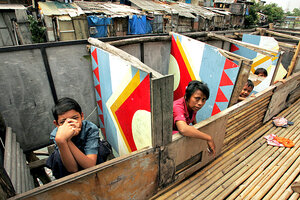Southeast Asian scientists look to reinvent the flush toilet
The 200-year-old flush toilet requires a substantial amount of infrastructure, which is expensive to build and run. Innovative toilets could be a source of energy while dramatically improving sanitation.

Indonesians use public toilets in a slum area of the capital, Jakarta. The Asian Institute for Technology has received a $5 million grant from the Bill & Melinda Gates Foundation to design toilets that could produce electricity or gas and improve sanitation, reducing illnesses and deaths.
Beawiharta Beawiharta/Reuters/File
BANGKOK, Thailand
Scientists in Bangkok are about to start work on a new flush toilet especially designed for the urban poor in Thailand, Cambodia, and Vietnam.
Their aim is to create a toilet that will process wastewater in family homes and convert it into gas or electricity, saving families money and protecting them from deadly diseases caused by poor sanitation.
The Bangkok-based Asian Institute for Technology (AIT) is receiving a $5 million grant from the Bill & Melinda Gates Foundation for the project, part of an estimated $380 million effort by the foundation to tackle sanitation problems in Asia and Africa.
RELATED: Top 10 nations lacking toilets
“The [flush] technology that we’ve been using so far is 200 years old already … It hasn’t really been improved at all [since],” Thammarat Koottatep, an environmental engineer and associate professor at AIT, said at the AIT project’s launch Sept. 24.
The current flush toilet requires a substantial amount of sewage infrastructure, which is expensive to build and run. The technology for re-using and recycling the byproducts of animal waste is already available and used in industry but has not yet been applied to toilets, Thammarat said.
Severe diarrhea caused by poor sanitation kills 1.5 million children worldwide each year, according to the Gates Foundation.
According to the East Meets West Foundation, a US nongovernmental organization and another recipient of Gates Foundation’s sanitation funds, 50 percent of households in Vietnam and around 80 percent of households in Cambodia do not have sanitation facilities.
Almost 99 percent of people in Thailand have access to toilets, said Thammarat, yet the issue is not just about access but also of efficient disposal of waste afterward.
“Safe sanitation means you should be able to reduce the contaminants or the pollutants after flushing the toilet,” and Thailand has not reached that stage, he said.
Thailand produces 20 million cubic meters (5.3 billion gallons) - the equivalent of 8,000 Olympic swimming pools - of domestic wastewater per day, according to AIT. But only 1.6 million cubic meters are collected in sewer networks and sent to treatment plants, many of which do not function.
Less than 10 percent of the 60,000 tons of fecal sludge collected per day is treated correctly.
“We have a problem of contamination, very highly polluted rivers and canals,” leading to foul-smelling waterways especially in the dry season, said Thammarat.
The key to providing extensive and safe sanitation coverage in Thailand, Cambodia, and Vietnam is to focus on decentralized systems, he said, often called septic or onsite systems, that focus at the household level.
Here, wastewater is treated close to the source, typically on the property of individual homes or businesses and saves owners the cost of connecting to a sewage system and eliminates the environmental burden of transporting large quantities of wastewater to a treatment plant.
In August, East Meets West received $10.9 million from the Gates Foundation, also to improve sanitation and hygiene practices, but this time among the rural poor in Vietnam and Cambodia.
Open defecation and the unsafe disposal of human waste in these two countries result in an estimated 17,000 deaths annually, 90 percent of which occur in children under age five, East Meets West said.
East Meets West’s program includes access to credible sources of financing for families to install latrines and hand-washing devices in their homes and conditional cash transfers to communes that achieve at least a 30 percent increase in sanitation coverage.
“The system we have [the flush toilet] only reaches one-third of the world’s population,” Doulaye Koné, a water and sanitation expert and senior program officer with the Gates Foundation said Sept. 24.
“It’s very expensive to buy this type of toilet, link it to kilometers and kilometers of sewer line, and build the kind of infrastructure that is needed to process it,” he added.
Yet he believes the problems can be fixed and he’s hoping to have more partners in Asia who will work with the organization on re-inventing the flush toilet.
• This article originally appeared at AlertNet, a humanitarian news site operated by the Thomson Reuters Foundation.
• Sign up to receive a weekly selection of practical and inspiring Change Agent articles by clicking here.

